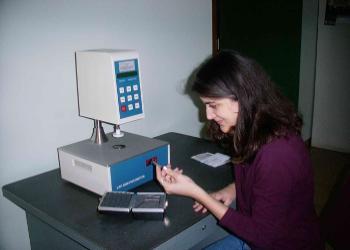Volume 2 Issue 3
What’s Happening at Missouri S&T: Formulation: Fall Short Course Schedule Set: CAP 2000L DONATION: The Missouri S&T Coatings Institute has received a donation of a new CAP 2000L cone and plate viscometer from the Brookfield Corporation. This viscometer is an excellent addition to our program. It will be utilized for our short course program as well as our undergraduate and graduate courses. The viscometer will also help with our research projects. Cone and plate viscometers are an excellent device to determine the basic effects of shear rate on viscosity for a coating.
Technical Insights on Coatings Science What Methods Are Best To Evaluate Stain? The term stain can mean many things. To some it is the evaluation of how much tannin bleeds through a coating or paint. It can also refer to mildew and fungus growth on the coating or paint on the exterior of a building. It can also be related to how stains such as lipstick, crayon, oil or ink bleed through a primer or paint. Finally it can be related to the coating’s ability to resist staining such as a coffee spill, wine, mustard or other potential stain. The tannin bleed through is usually evaluated by covering a variety of wood samples with a coating and evaluating whether the tannin comes through the paint. This is a general evaluation for most hiding primers. Spectrophotometer evaluation or visual inspection can be utilized in the evaluation. Generally the spectrophotometer can be more reproducible from day to day and from lab to lab. The evaluation of soiling or staining by mildew and fungus growth is usually done in an environmental chamber or through exterior exposure studies and is typically evaluated visually. The rating is therefore somewhat subjective. Quantification of growth of these stains is difficult since each growth can have different pigmentation. The stain bleed through resistance is generally evaluated by placing a stain on drywall and then applying the primer over the stain. Visual evaluation or spectral evaluation can then be employed to quantify the stain. A control of the primer over clean drywall is used for comparison. The final stain evaluation is by stain resistance. The coating is applied to a surface such as wood and then allowed to fully dry. The stain is then applied and allowed to set for a period of time (1-24 hours generally). The surface is then washed and the stain removal efficacy evaluated. The spectrophotometer or visual evaluation can again be employed. The above are the most commonly employed general tests. Other evaluations can include oil, perspiration, acid, base, alcohol, gas, naphtha, transmission oil, and many other possible stains. The end use defines the need. The next time someone asks if a coating resists staining, be sure you know what the person is defining as staining! Freeze-Thaw Cycling? An interesting correlation can be made when evaluating the freeze-thaw cycling of paints. When the paint freezes part of the water turns to ice. When the paint is removed from the freezer, the ice will melt. The heat required to melt the ice is the heat of fusion. The more ice that has formed the more time that is required for the ice to melt. If several paints of unknown composition are evaluated, the paint with the most ice will also usually require the longest time to come up to room temperature. We have noted that some water borne coatings will not return to normal viscosity within 7 hours but may require 8-12 hours to return to normal in both temperature and viscosity. Many factors affect the rheological properties of the paint during this period. These points are beyond the scope of this brief article. It is sufficient here to indicate that the evaluation of freeze thaw cycles has become more critical in recent years as we increase the use of water borne technology and decrease the amount of glycol we put into our coatings to prevent freeze thaw instability.
|
| September 12-16, 2005 Basic Composition of Coatings This course provides an overview of the components of paint and how they work. Participants are also introduced to methods for testing and manufacture of paint. |
| May 16-20, 2005 Introduction to Paint Formulation This course provides techniques used in formulating paint from raw materials. It involves formulating and making paint in the laboratory, "Hands on!" |
| Coatings for Engineers available on-line anytime This course is designed to educate engineers in coatings science. Coatings systems will be covered from cleaning and surface prep to pretreatment, priming and topcoats. Specification and testing sections will aid all engineers who are charged with these tasks. |
To subscribe/unsubscribe to this newsletter, click here. Feel free to forward to this your colleagues. |

